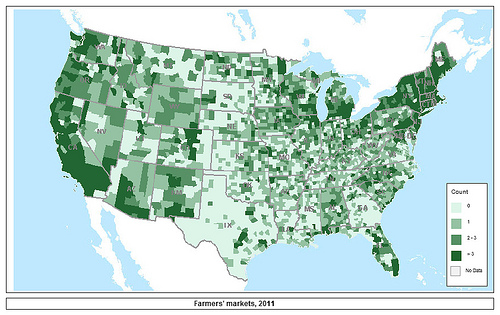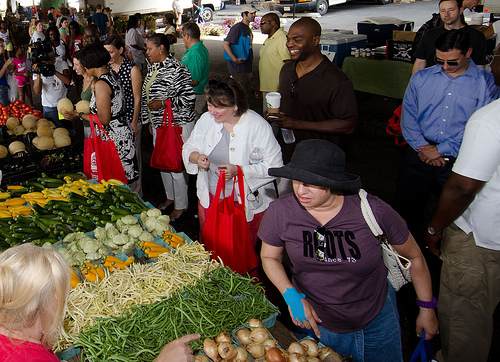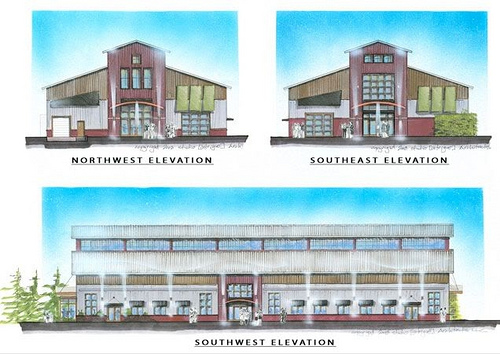
Number of Farmers Markets per County, 2011 (darkest areas have higher numbers). More than 7,800 farmers markets have sprung up across the United States, up from roughly 1,700 in 1994.
This post is part of the Science Tuesday feature series on the USDA blog. Check back each week as we showcase stories and news from USDA’s rich science and research profile.
Interest in local and regional food systems has expanded in recent years. The evidence is everywhere: from the number of farmers markets more than doubling nationwide since 2004, to the rising popularity of “community supported agriculture” (CSA) participation, to the increasingly common sight of restaurants and retail grocery outlets stocking and promoting meat and produce from local farmers and ranchers. This consumer trend has implications for the farms that supply these markets, firms across the retail supply chain, and policy makers at the federal, state and local levels that often promote local foods in various nutrition, food assistance and community development programs. Read more »

Agriculture Deputy Secretary Kathleen Merrigan (center, white jacket) buys produce at the Baltimore farmers market in Baltimore, MD. By supporting farmers markets and other businesses, Farmers Market Promotion Program funds have helped open new doors for farmers and ranchers all across the country.
Last Friday, I was honored to announce $9 million in new grants through USDA’s Farmers Market Promotion Program (FMPP). The program targets producers, cooperatives and organizations that market products directly to consumers – just one of the many marketing approaches that make American agriculture so successful. Read more »
Young toddlers and children crowded the tents, shuffling and giggling, as they waited for their parents to purchase produce for the family. The Arlington Farmers’ Market was filled with customers who participate in the Women, Infants and Children program (WIC) and farmers who were excited to cater to the enormous turn out. Well over 200 families came out in the mid-morning heat of Texas to receive their Farmers’ Market Nutrition Program (FMNP) vouchers.
Through the FMNP, WIC participants are able to access locally grown fruits, vegetables, and herbs that promote the well being and health of themselves and/or their children. Just last year in 2011, 1.9 million WIC participants received FMNP benefits, which, when redeemed, surpassed 16.4 million dollars in total revenue for participating farmers and farmer’s markets.
On hand this day were Ann Salyer-Caldwell, Tarrant County WIC Director, Sam Varela, the FMNP State Director of Texas Department of Agriculture, Kay Dillard, the Director of the Tarrant Area Food Bank, Dorothy “Toni” Savage-Oakford, a community health worker with the Tarrant County Health Department, and Samantha Swain, the local FMNP Coordinator. Read more »

A vendor places tomatoes into a plastic bag for a customer at a Maryland farmers market. Many beginning producers use farmers markets as the gateway to direct marketing opportunities. Photo by Elvert Barnes
This week we’ve celebrated farmers markets as a vibrant segment of U.S. agriculture that offers a unique and personal way to connect producers and consumers. We highlighted decades of farmers market participation, updated the status of farmers markets across the U.S., offered an example of innovation in the lessons learned by a market in Kentucky, and explained how structure and function interact through farmers market architecture. Now, with National Farmers Market Week coming to a close tomorrow, we thought we should share some perspective on how farmers markets fit into the larger local and regional food landscape. Read more »

A design concept for the outside of Michigan’s indoor/outdoor market arena. After developing a design concept, Fidel Delgado, AMS Architect, provides cost estimates and a feasibility assessment.
Farmers markets are evolving. They are moving away from seasonal, parking lot produce stands and becoming year-round, self-sustaining, community hubs. As more and more cities and communities look for ways to strengthen their local economies, we’ve seen more emphasis placed on both the infrastructure and the actual structure of their farmers markets. That’s where I come in. Read more »

USDA Deputy Secretary Kathleen Merrigan (center, white jacket) buys produce during a July trip to visit the Baltimore farmers market in Maryland. The mid-Atlantic region saw double-digit growth in its listings in the National Farmers Market Directory. Maryland added 76 new market listings alone. USDA Photo by Lance Cheung.
We’ve known for some time that local food is a vibrant and growing sector in agriculture. Consumers are seeking out food produced in their region, and this local food – whether it’s purchased at a farmers market, in a grocery store, at a restaurant or elsewhere – is now a multi-billion dollar industry. This week, we received further evidence of the strength of consumer demand for local foods. The National Farmers Market Directory, compiled by USDA’s Agricultural Marketing Service (AMS), has just been updated and shows a nearly 10 percent increase in listings over last year. Read more »




